Stephen Gould
Sharper Convergence Rates for Nonconvex Optimisation via Reduction Mappings
Jun 10, 2025Abstract:Many high-dimensional optimisation problems exhibit rich geometric structures in their set of minimisers, often forming smooth manifolds due to over-parametrisation or symmetries. When this structure is known, at least locally, it can be exploited through reduction mappings that reparametrise part of the parameter space to lie on the solution manifold. These reductions naturally arise from inner optimisation problems and effectively remove redundant directions, yielding a lower-dimensional objective. In this work, we introduce a general framework to understand how such reductions influence the optimisation landscape. We show that well-designed reduction mappings improve curvature properties of the objective, leading to better-conditioned problems and theoretically faster convergence for gradient-based methods. Our analysis unifies a range of scenarios where structural information at optimality is leveraged to accelerate convergence, offering a principled explanation for the empirical gains observed in such optimisation algorithms.
DiSA: Diffusion Step Annealing in Autoregressive Image Generation
May 26, 2025Abstract:An increasing number of autoregressive models, such as MAR, FlowAR, xAR, and Harmon adopt diffusion sampling to improve the quality of image generation. However, this strategy leads to low inference efficiency, because it usually takes 50 to 100 steps for diffusion to sample a token. This paper explores how to effectively address this issue. Our key motivation is that as more tokens are generated during the autoregressive process, subsequent tokens follow more constrained distributions and are easier to sample. To intuitively explain, if a model has generated part of a dog, the remaining tokens must complete the dog and thus are more constrained. Empirical evidence supports our motivation: at later generation stages, the next tokens can be well predicted by a multilayer perceptron, exhibit low variance, and follow closer-to-straight-line denoising paths from noise to tokens. Based on our finding, we introduce diffusion step annealing (DiSA), a training-free method which gradually uses fewer diffusion steps as more tokens are generated, e.g., using 50 steps at the beginning and gradually decreasing to 5 steps at later stages. Because DiSA is derived from our finding specific to diffusion in autoregressive models, it is complementary to existing acceleration methods designed for diffusion alone. DiSA can be implemented in only a few lines of code on existing models, and albeit simple, achieves $5-10\times$ faster inference for MAR and Harmon and $1.4-2.5\times$ for FlowAR and xAR, while maintaining the generation quality.
VI3NR: Variance Informed Initialization for Implicit Neural Representations
Apr 27, 2025Abstract:Implicit Neural Representations (INRs) are a versatile and powerful tool for encoding various forms of data, including images, videos, sound, and 3D shapes. A critical factor in the success of INRs is the initialization of the network, which can significantly impact the convergence and accuracy of the learned model. Unfortunately, commonly used neural network initializations are not widely applicable for many activation functions, especially those used by INRs. In this paper, we improve upon previous initialization methods by deriving an initialization that has stable variance across layers, and applies to any activation function. We show that this generalizes many previous initialization methods, and has even better stability for well studied activations. We also show that our initialization leads to improved results with INR activation functions in multiple signal modalities. Our approach is particularly effective for Gaussian INRs, where we demonstrate that the theory of our initialization matches with task performance in multiple experiments, allowing us to achieve improvements in image, audio, and 3D surface reconstruction.
Interior Point Differential Dynamic Programming, Redux
Apr 11, 2025Abstract:We present IPDDP2, a structure-exploiting algorithm for solving discrete-time, finite horizon optimal control problems with nonlinear constraints. Inequality constraints are handled using a primal-dual interior point formulation and step acceptance for equality constraints follows a line-search filter approach. The iterates of the algorithm are derived under the Differential Dynamic Programming (DDP) framework. Our numerical experiments evaluate IPDDP2 on four robotic motion planning problems. IPDDP2 reliably converges to low optimality error and exhibits local quadratic and global convergence from remote starting points. Notably, we showcase the robustness of IPDDP2 by using it to solve a contact-implicit, joint limited acrobot swing-up problem involving complementarity constraints from a range of initial conditions. We provide a full implementation of IPDDP2 in the Julia programming language.
Scaling Prompt Instructed Zero Shot Composed Image Retrieval with Image-Only Data
Apr 01, 2025Abstract:Composed Image Retrieval (CIR) is the task of retrieving images matching a reference image augmented with a text, where the text describes changes to the reference image in natural language. Traditionally, models designed for CIR have relied on triplet data containing a reference image, reformulation text, and a target image. However, curating such triplet data often necessitates human intervention, leading to prohibitive costs. This challenge has hindered the scalability of CIR model training even with the availability of abundant unlabeled data. With the recent advances in foundational models, we advocate a shift in the CIR training paradigm where human annotations can be efficiently replaced by large language models (LLMs). Specifically, we demonstrate the capability of large captioning and language models in efficiently generating data for CIR only relying on unannotated image collections. Additionally, we introduce an embedding reformulation architecture that effectively combines image and text modalities. Our model, named InstructCIR, outperforms state-of-the-art methods in zero-shot composed image retrieval on CIRR and FashionIQ datasets. Furthermore, we demonstrate that by increasing the amount of generated data, our zero-shot model gets closer to the performance of supervised baselines.
ARINAR: Bi-Level Autoregressive Feature-by-Feature Generative Models
Mar 04, 2025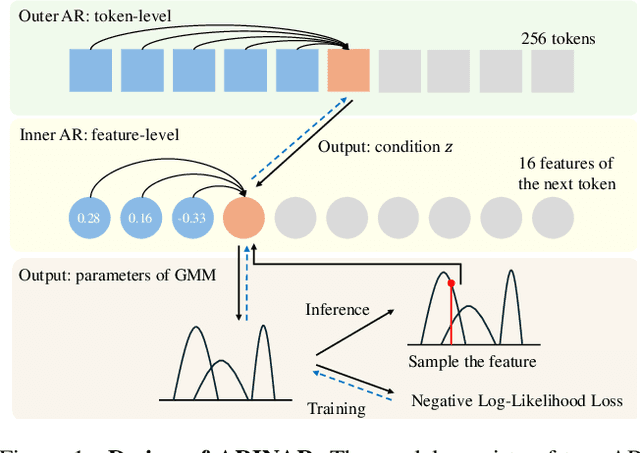
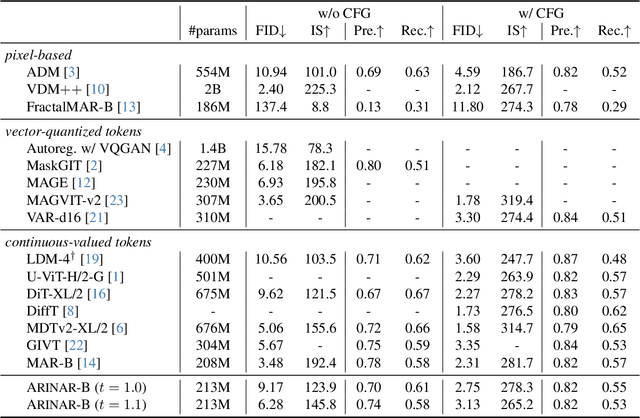

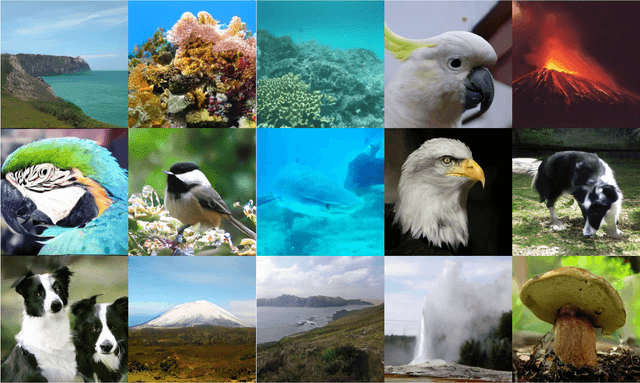
Abstract:Existing autoregressive (AR) image generative models use a token-by-token generation schema. That is, they predict a per-token probability distribution and sample the next token from that distribution. The main challenge is how to model the complex distribution of high-dimensional tokens. Previous methods either are too simplistic to fit the distribution or result in slow generation speed. Instead of fitting the distribution of the whole tokens, we explore using a AR model to generate each token in a feature-by-feature way, i.e., taking the generated features as input and generating the next feature. Based on that, we propose ARINAR (AR-in-AR), a bi-level AR model. The outer AR layer take previous tokens as input, predicts a condition vector z for the next token. The inner layer, conditional on z, generates features of the next token autoregressively. In this way, the inner layer only needs to model the distribution of a single feature, for example, using a simple Gaussian Mixture Model. On the ImageNet 256x256 image generation task, ARINAR-B with 213M parameters achieves an FID of 2.75, which is comparable to the state-of-the-art MAR-B model (FID=2.31), while five times faster than the latter.
Negative Token Merging: Image-based Adversarial Feature Guidance
Dec 02, 2024



Abstract:Text-based adversarial guidance using a negative prompt has emerged as a widely adopted approach to push the output features away from undesired concepts. While useful, performing adversarial guidance using text alone can be insufficient to capture complex visual concepts and avoid undesired visual elements like copyrighted characters. In this paper, for the first time we explore an alternate modality in this direction by performing adversarial guidance directly using visual features from a reference image or other images in a batch. In particular, we introduce negative token merging (NegToMe), a simple but effective training-free approach which performs adversarial guidance by selectively pushing apart matching semantic features (between reference and output generation) during the reverse diffusion process. When used w.r.t. other images in the same batch, we observe that NegToMe significantly increases output diversity (racial, gender, visual) without sacrificing output image quality. Similarly, when used w.r.t. a reference copyrighted asset, NegToMe helps reduce visual similarity with copyrighted content by 34.57%. NegToMe is simple to implement using just few-lines of code, uses only marginally higher (<4%) inference times and generalizes to different diffusion architectures like Flux, which do not natively support the use of a separate negative prompt. Code is available at https://negtome.github.io
Manual-PA: Learning 3D Part Assembly from Instruction Diagrams
Nov 27, 2024



Abstract:Assembling furniture amounts to solving the discrete-continuous optimization task of selecting the furniture parts to assemble and estimating their connecting poses in a physically realistic manner. The problem is hampered by its combinatorially large yet sparse solution space thus making learning to assemble a challenging task for current machine learning models. In this paper, we attempt to solve this task by leveraging the assembly instructions provided in diagrammatic manuals that typically accompany the furniture parts. Our key insight is to use the cues in these diagrams to split the problem into discrete and continuous phases. Specifically, we present Manual-PA, a transformer-based instruction Manual-guided 3D Part Assembly framework that learns to semantically align 3D parts with their illustrations in the manuals using a contrastive learning backbone towards predicting the assembly order and infers the 6D pose of each part via relating it to the final furniture depicted in the manual. To validate the efficacy of our method, we conduct experiments on the benchmark PartNet dataset. Our results show that using the diagrams and the order of the parts lead to significant improvements in assembly performance against the state of the art. Further, Manual-PA demonstrates strong generalization to real-world IKEA furniture assembly on the IKEA-Manual dataset.
Guiding Neural Collapse: Optimising Towards the Nearest Simplex Equiangular Tight Frame
Nov 02, 2024



Abstract:Neural Collapse (NC) is a recently observed phenomenon in neural networks that characterises the solution space of the final classifier layer when trained until zero training loss. Specifically, NC suggests that the final classifier layer converges to a Simplex Equiangular Tight Frame (ETF), which maximally separates the weights corresponding to each class. By duality, the penultimate layer feature means also converge to the same simplex ETF. Since this simple symmetric structure is optimal, our idea is to utilise this property to improve convergence speed. Specifically, we introduce the notion of nearest simplex ETF geometry for the penultimate layer features at any given training iteration, by formulating it as a Riemannian optimisation. Then, at each iteration, the classifier weights are implicitly set to the nearest simplex ETF by solving this inner-optimisation, which is encapsulated within a declarative node to allow backpropagation. Our experiments on synthetic and real-world architectures for classification tasks demonstrate that our approach accelerates convergence and enhances training stability.
Neural Experts: Mixture of Experts for Implicit Neural Representations
Oct 29, 2024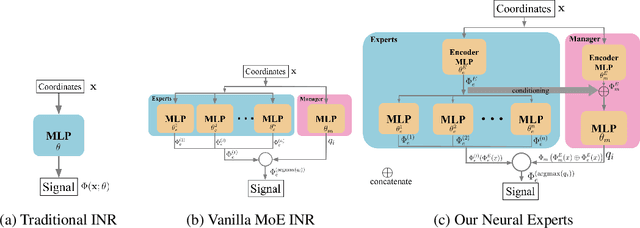
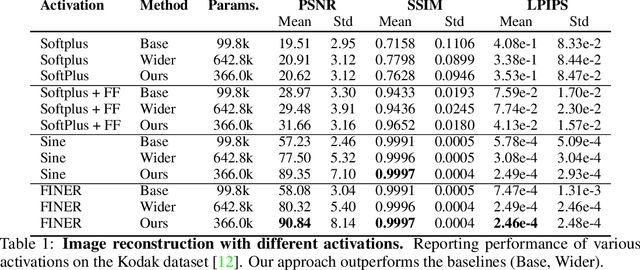


Abstract:Implicit neural representations (INRs) have proven effective in various tasks including image, shape, audio, and video reconstruction. These INRs typically learn the implicit field from sampled input points. This is often done using a single network for the entire domain, imposing many global constraints on a single function. In this paper, we propose a mixture of experts (MoE) implicit neural representation approach that enables learning local piece-wise continuous functions that simultaneously learns to subdivide the domain and fit locally. We show that incorporating a mixture of experts architecture into existing INR formulations provides a boost in speed, accuracy, and memory requirements. Additionally, we introduce novel conditioning and pretraining methods for the gating network that improves convergence to the desired solution. We evaluate the effectiveness of our approach on multiple reconstruction tasks, including surface reconstruction, image reconstruction, and audio signal reconstruction and show improved performance compared to non-MoE methods.
 Add to Chrome
Add to Chrome Add to Firefox
Add to Firefox Add to Edge
Add to Edge